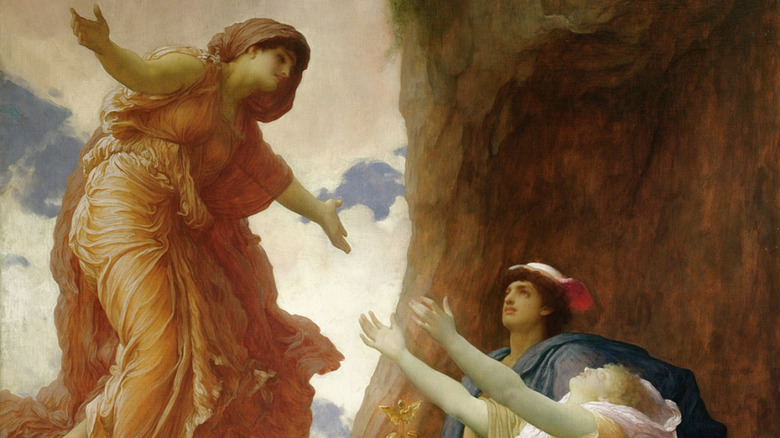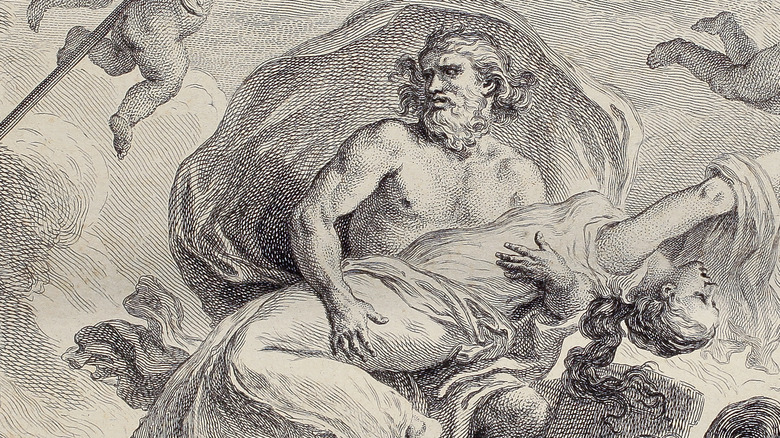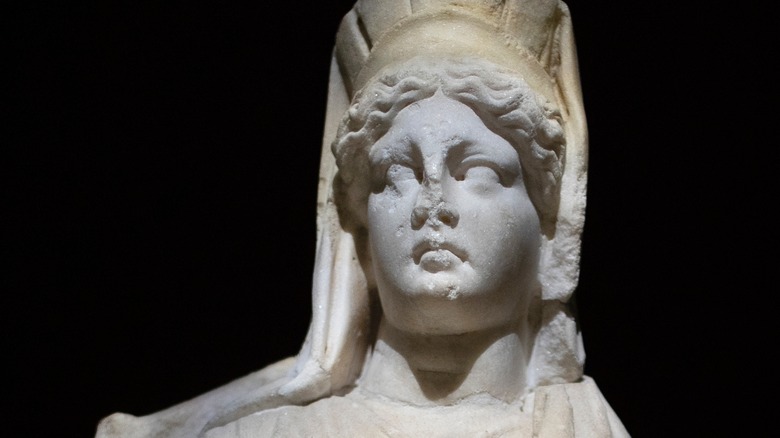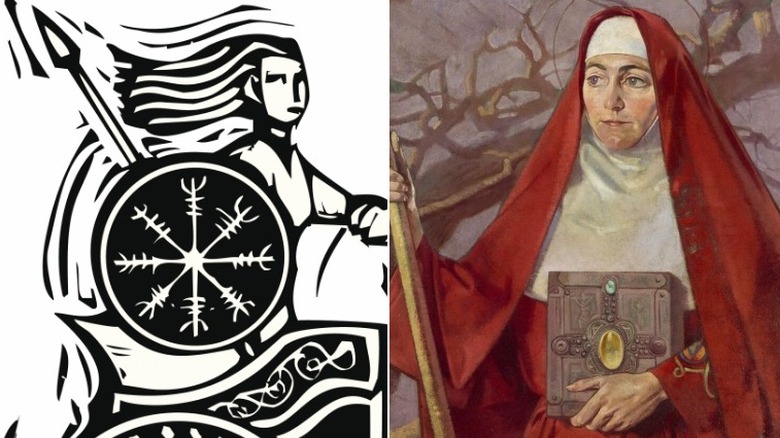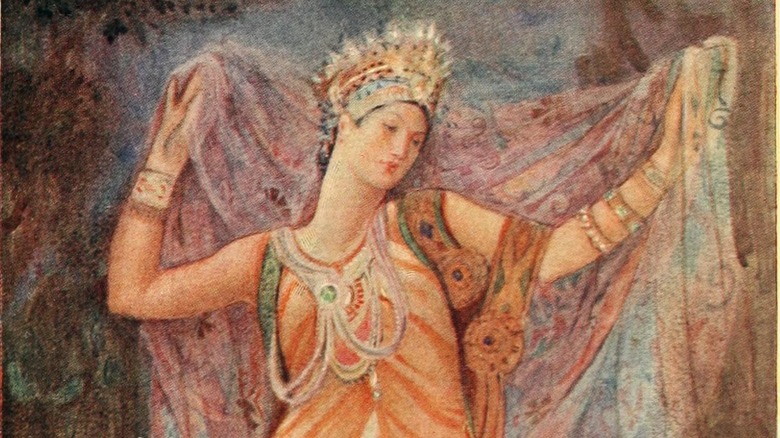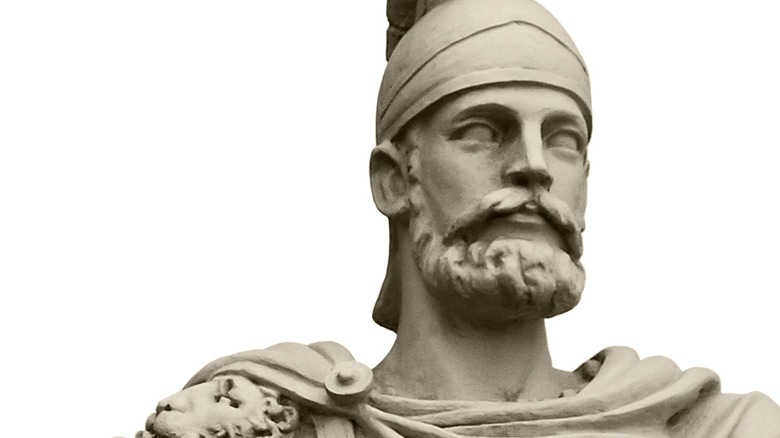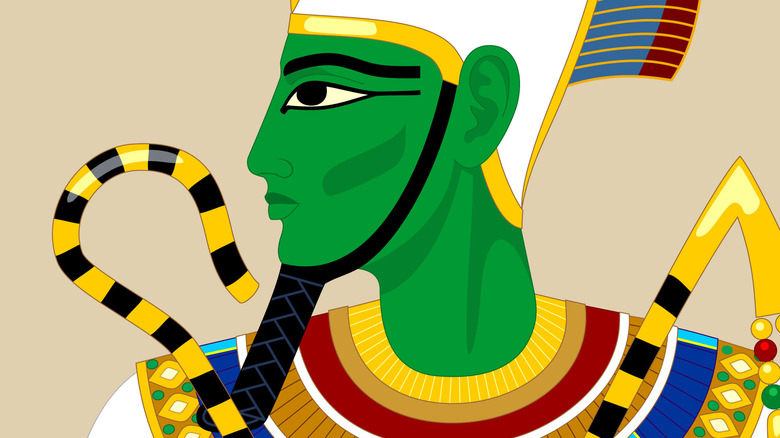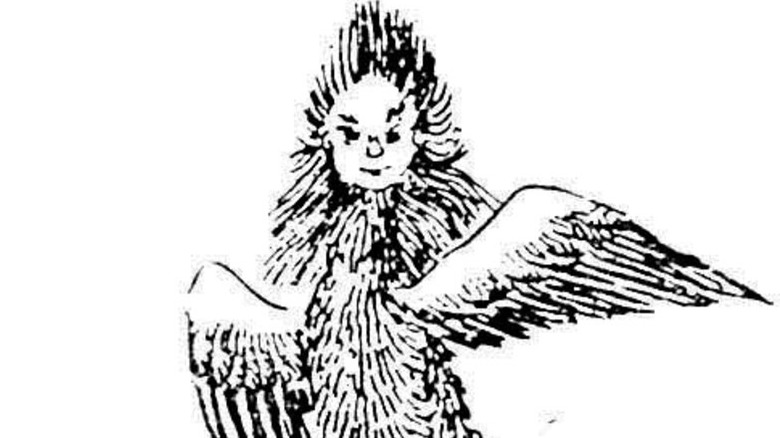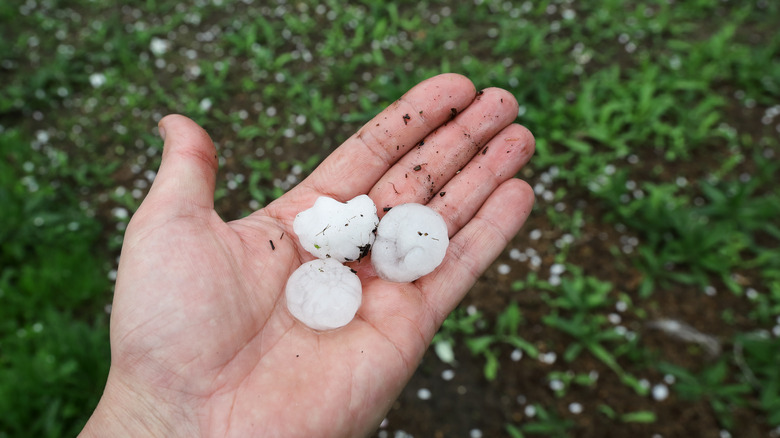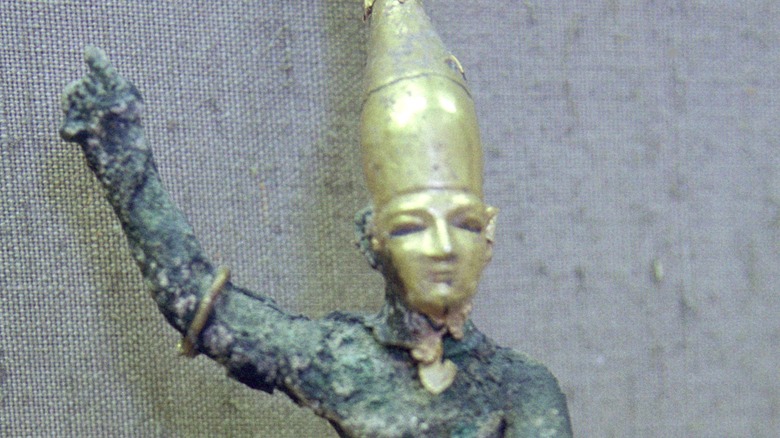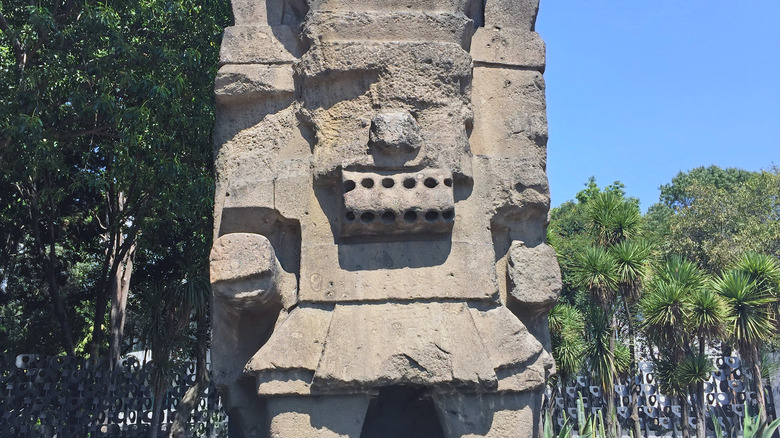Spring Explained By Ancient Gods And Myths
Human beings have always used stories to try to understand the world around them. Throughout history, people have developed myths and legends to try to explain why the weather and temperature change in cycles. Ancient peoples relied on their harvests for survival, so it's not surprising that the startling transformation from harsh winter to lush and fertile spring was particularly fascinating.
In some cultures, it was believed that gods and goddesses demanded sacrifices and offerings in exchange for good weather. When the temperature makes the difference between life and death, it's easy to understand why people would be desperate to know which gods they had to appease to bring back their crops. Some legends link winter with the grief of a powerful deity and suggest that they are reunited with their loved ones in the spring. Others believed that the return of spring was directly caused by a god rising from the dead. Although in modern times most have a more scientific understanding of the changing seasons, there is still a lot to be learned about humanity from these ancient mythological explanations for spring.
Demeter reunites with her daughter
In Greek mythology, Demeter is a powerful earth goddess who makes plants grow and flowers bloom. Unfortunately, her beautiful daughter Persephone caught the attention of the terrifying Hades, the god of death. In modern retellings, Hades and Persephone are often depicted as an unlikely romance. Traditionally, they came together through a kidnapping.
When Persephone vanished, her distraught mother searched everywhere for her. The sun god Helios saw how devastated Demeter was and told her the truth: A massive chasm had opened up in the ground and Hades had carried Persephone down to the underworld. Demeter wasn't able to rescue Persephone herself, but she could go on strike.
Demeter refused to make the plants grow. A terrible drought spread across the entire world. There was no food, and it seemed like every living thing would starve. Finally, the desperate gods interceded on Demeter's behalf, ordering Hades to release Persephone. Hades had to obey, but he had one last trick to play. While Persephone had been in the underworld, she had eaten pomegranate seeds, which symbolize both marriage and triumph in battle. For four months of the year, one for each seed she ate, Persephone would have to live in the underworld as Hades' queen. This was the ancient Greek explanation for the changing seasons: While Persephone is in the land of the dead, Demeter mourns and nothing grows, and the world experiences winter. In the spring, Persephone returns to her mother, and plants can grow again.
The Great Mother of the Gods resurrects the plants
Worship of the Great Mother of the Gods is believed to have begun in modern-day Turkey. There she was described as the mother of everything, from mountains to gods. Without her, there would be no life. In Rome, she was worshiped under the name Cybele. There, she was primarily seen as a goddess of agriculture, fertility, and resurrection. She was credited with making plants flourish. Unlike some agriculture gods, she was a brutal figure who demanded sacrifice to bring life back in the spring.
The most famous myth about Cybele involves her relationship with another earth god called Attis. In the most popular version of the myth, Attis fell in love with a human woman, even though he was Cybele's lover. Furious at the betrayal, Cybele cursed him. Under the influence of her cruel magic, he violently injured himself, and eventually died. Cybele was overwhelmed with regret, and along with the help of Zeus, the king of the gods, she brought Attis back from the dead.
Both Cybele and Attis were associated with plants, and his torment and death symbolized the way that plants die off in the winter. Cybele bringing Attis back from the dead was thought to also resurrect the plants. In the Roman Empire, Cybele was honored every spring with what is believed to have been an extremely debauched festival, which may have included sexual exploration and ritual human sacrifice.
The Chinook wind brings the warm weather
The term "Chinook wind" refers to sudden, sometimes violent winds which blow through the American West at the beginning of spring. These winds begin around Washington and Oregon state, which is the ancestral home of the Chinook people, and become more powerful as they blow East. Chinook winds bring extreme temperature changes with them. Often, after Chinook winds have passed through, it will be between 25 and 50 degrees Fahrenheit warmer.
The Indigenous peoples who lived in these regions were well aware of these winds and had stories about them. In one Siksika (Blackfoot) story, recounted in "When Bear Stole the Chinook" the Chinook wind is captured by the great Bear, which makes winter last until it is freed by an intrepid young boy from the Siksika tribe and his animal friends. In other legends, the Chinook wind is a sentient being, bringing warm weather on purpose. One of these, recorded by anthropologist Arthur C. Ballard (via the Burke Museum) depicts a war between the North Wind, who wants to make winter last forever, and the Storm Wind, son of the Chinook Wind, who must violently avenge his father and chase winter away every year.
Brigid was the embodiment of spring
In Ireland, the beginning of spring is celebrated on February 1, which is known as St. Brigid's Day. In Catholic legend, St. Brigid is described as a girl who converted to Christianity and became Ireland's first nun. On St. Brigid's Day, a straw effigy of the saint is put into the ocean. This tradition may seem strange, but it hints at a much older spring celebration, which predates Christianity. Before she was a saint, Brigid was a goddess.
Brigid or Brid was the goddess of the spring season and was considered among the most powerful of the Celtic gods. She was part of a trinity of her own, three goddesses called Brigid, who were all aspects of the same deity. Ancient believers saw Brigid as a goddess of many things, from fire to poetry, but she may have been best known as the goddess of spring, who brought fertility to people and the land alike. Modern St. Brigid's day falls on the same day as the festival which honored the goddess Brigid: Imbolc. During Imbolc, believers created huge bonfires and built reed effigies to honor Brigid and celebrate the return of spring.
Ishtar's son returns from the underworld
The powerful ancient Babylonian deity Ishtar was the goddess of sex, war, and storms. She is depicted as being chaotic and changeable — just as likely to ruin lives as save them. In one famous legend, her tendency to make rash and violent decisions transformed the world forever.
Ishtar had a son named Tammuz who she sent to live in the mortal world. As described in "Ishtar and Tammuz: A Babylonian Myth of the Seasons," he became known as the "Green One" and humans and animals alike flocked to him to celebrate how he made the world beautiful and lush with plant life. At first, Ishtar was proud, but as he became more and more beloved, her pride turned to jealousy and she struck him down.
With Tammuz dead, all of the plant life that he had created died, too. The world became a desolate place, full of starvation, drought, and sorrow. Ishtar was grieving too, and she traveled to the underworld to get Tammuz back. There, Ishtar had to bargain with her sister Allatu, the terrifying half-lioness queen of the dead. In the end, Ishtar was able to bring Tammuz back to life, but only if he would return to the underworld for half of the year. This was the ancient Mesopotamian explanation for the changing of the seasons. When Tammuz is in the underworld, everything is barren. But in Spring, when Tammuz returns, he transforms the world into a verdant paradise.
Mars trades spring for sacrifices
The god Mars is generally known as the god of war, but in ancient Rome, Sparta, and Greece, he was considered responsible for more than just the military. It is believed that he was worshiped in both the spring and fall, when new growth began and when crops were harvested. The name for the month of March, when spring begins in Italy, is actually named for the god Mars. There were multiple festivals and celebrations worshiping him in the spring to help with the harvest, but just because they reflected a more agricultural side of Mars doesn't mean that they didn't also reflect his violent nature.
One of these rituals is known as Ver Sacrum or "Sacred Spring." As described in "Harpers Dictionary of Classical Antiquities," when there was famine, drought, or other terrible conditions for the ancient Italians, it was believed that ritual sacrifices were the only way to persuade Mars to bring back the good weather and bountiful harvests. The ancient Italians would promise that everything which grew in March and April belonged to Mars, incentivizing him to make it a profitable season. All livestock that was born and crops that grew were given as offerings. Often, children who were born in these months were forced out of the community when they reached adulthood and occasionally were sacrificed along with the cattle.
Osiris rises from the dead
Life in Ancient Egypt was possible because of the flooding of the Nile river. The floods could be deadly and destructive, but they also made the land fertile — an agricultural oasis in the desert. This apparent contradiction is reflected in one of the most important gods in the Ancient Egyptian pantheon: Osiris.
The Ancient Egyptian calendar only had three seasons: Shemu, when crops were ready for harvest; Akhet, when the Nile flooded; and Peret, which is most closely related to spring because it is when plants began to sprout. Osiris is both the god of death and the god of agriculture and was thought to be personally responsible for making the Nile flood and the plants grow.
Osiris is not only considered responsible for the flooding of the Nile. His most famous legend represents the changing of the seasons. Famously, Osiris's brother Set drowned him in the Nile, tore apart the body, and scattered the pieces throughout Egypt. Osiris' beloved wife Isis reassembled the pieces and brought him back from the dead. This cycle of death and rebirth echoes both the flooding of the Nile and the changing of the seasons.
Goumang brings the harvest
In China, there is a traditional ceremony that dates back hundreds of years to celebrate the coming of spring. It was also designed to ensure a good harvest for the community by winning the favor of a very important god. The ceremony lasts all day and includes the ritual plowing of a field, singing and chanting that welcomes the new season, and giving offerings of flowers to Goumang, an ancient god of spring.
Goumang (sometimes spelled Jumang) was known as the god of life, so it is unsurprising that he was also credited with breathing life back into the natural world after the long, harsh winter. He is often described as a massive bird with a human man's face, but sometimes he appears as a human man with the head of a bird instead. In ancient times, it was believed that the offerings he received at the festival at the beginning of spring encouraged Goumang to provide the community with a good harvest.
Morityema lives on a mountain
Most spring gods are believed to be responsible for bringing warm weather and new plant growth, but for the people living in what is now the Southwestern United States, the spirit of spring also created some less pleasant weather.
According to stories from some Indigenous tribes, including the Navajo and Pueblo, the world had four corners. It was thought that there were tall mountains at each corner of the world, and each was home to the spirit of one of the four seasons. These spirits were often in competition with each other over what the world should be like. While the spirits of the warmer seasons loved foliage, the spirit of fall found plants repulsive and worked to eradicate them every year, causing the change in seasons.
The spirit of spring is known as Morityema. As described in "The Ethnographic American Southwest," each spirit had a staff that they used to control the weather. Morityema's staff created hailstorms. While this power sets him apart from other spring gods and goddesses, hailstorms can be a major part of spring in the region where Morityema's believers lived, where balls of ice falling from the sky can be as wide as three inches.
Yarilo rides in on a white horse
Yarilo is a beautiful god that is always barefoot, wearing all white, riding a white horse, and wearing a crown made of flowers. He is male, but he is described as very feminine. Despite his soft and gentle appearance, Yarilo is one of the most powerful gods in Slavic legends and demands human sacrifice to bring back the harvest.
As described in "Slavic Sorcery: Shamanic Journey of Initiation," Yarilo was worshipped in a festival at the beginning of spring. Believers would gather, wearing wildflowers in their hair and joining hands to dance in circles. Some believe that this ceremony became increasingly chaotic and frenzied, and often included intoxication and sexual exploration. In some depictions, one woman, called the bride of Yarilo, would die during the ritual.
Whether or not this ritual was ever really performed, Yarilo is deeply associated with death and resurrection. It was believed that as a god of the harvest, Yarilo died at the summer solstice, and his believers honored him with a kind of symbolic funeral. It was also believed that he rose again every spring with new growth.
Baal returns from the underworld
In Canaanite legends, whose believers lived in modern-day Syria, Lebanon, Israel, and Jordan, the god Baal was responsible for the changing of the seasons. Baal was predominantly the god of storms, but in this mostly harsh and arid region, rainstorms were seen as an incredible thing that restored the land. As a result, Baal was beloved rather than feared.
Baal is a protector of humanity and eventually becomes king of the universe. First, he had to go to war with the ocean, disease, fire, and then death itself. In this epic legend, Baal defeats many enemies but then is tricked into entering the land of the dead. His allies eventually rescued him and Baal was able to battle and conquer death, but while he was trapped in the underworld, there was no rain in the land of the living. Nothing could grow, and everyone suffered. This legend tells the story of how Baal conquered the world, but it also provides an explanation for why nothing can grow in winter. In spring, Baal returns to the land of the living and takes his rightful place as king. Afterward, the harvest can flourish again.
Tláloc controls the rain
The ancient Aztec god Tláloc was seen as being as unpredictable as the weather that he controlled. Sometimes he was humanity's savior, creating the rains that made the crops grow. He could also be a violent and bloodthirsty god, leaving the world dry and barren or flooding the earth with storms. It was believed that Tláloc kept rain, drought, disease, and frost in a set of sacred jars, and could unleash them on humanity however he saw fit.
Tláloc was thought to be solely responsible for bringing back a time of agricultural prosperity, and so at the beginning of the wet season in April or May, the Aztecs performed a ritual to honor Tláloc in hopes that he would be merciful. It was believed that Tláloc lived in a paradise called Tlālōcān, where it was always spring and there was always growth and life. Historians suspect that the Aztecs may have associated this paradise with Mount Tlaloc. It is thought that believers made an annual journey to the mountain with offerings from the previous year's harvest. They likely also sacrificed living humans to Tláloc. It is believed that many of these victims were children and that when they cried, it was seen as a sign that Tláloc would soon make it rain.
